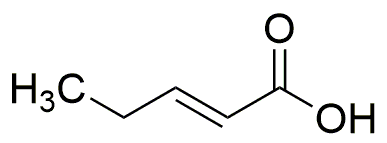trans-2-Pentenoic acid is widely utilized in research focused on:
- Flavor and Fragrance Industry: This compound is used as a flavoring agent in food products and as a fragrance component in perfumes, providing a unique fruity aroma that enhances sensory experiences.
- Synthesis of Pharmaceuticals: It serves as an important intermediate in the synthesis of various pharmaceutical compounds, aiding in the development of medications with specific therapeutic effects.
- Polymer Production: The chemical is utilized in the production of specialty polymers, contributing to materials with enhanced properties such as flexibility and durability, which are crucial in packaging and coatings.
- Research in Organic Chemistry: It is a valuable reagent in organic synthesis, allowing researchers to explore new chemical reactions and develop innovative compounds for various applications.
- Agricultural Chemicals: The compound finds applications in the formulation of agrochemicals, helping to improve crop yields and pest resistance through its role in developing effective herbicides and pesticides.
General Information
Properties
Safety and Regulations
Applications
trans-2-Pentenoic acid is widely utilized in research focused on:
- Flavor and Fragrance Industry: This compound is used as a flavoring agent in food products and as a fragrance component in perfumes, providing a unique fruity aroma that enhances sensory experiences.
- Synthesis of Pharmaceuticals: It serves as an important intermediate in the synthesis of various pharmaceutical compounds, aiding in the development of medications with specific therapeutic effects.
- Polymer Production: The chemical is utilized in the production of specialty polymers, contributing to materials with enhanced properties such as flexibility and durability, which are crucial in packaging and coatings.
- Research in Organic Chemistry: It is a valuable reagent in organic synthesis, allowing researchers to explore new chemical reactions and develop innovative compounds for various applications.
- Agricultural Chemicals: The compound finds applications in the formulation of agrochemicals, helping to improve crop yields and pest resistance through its role in developing effective herbicides and pesticides.
Documents
Safety Data Sheets (SDS)
The SDS provides comprehensive safety information on handling, storage, and disposal of the product.
Product Specification (PS)
The PS provides a comprehensive breakdown of the product’s properties, including chemical composition, physical state, purity, and storage requirements. It also details acceptable quality ranges and the product's intended applications.
Certificates of Analysis (COA)
Search for Certificates of Analysis (COA) by entering the products Lot Number. Lot and Batch Numbers can be found on a product’s label following the words ‘Lot’ or ‘Batch’.
*Catalog Number
*Lot Number
Certificates Of Origin (COO)
This COO confirms the country where the product was manufactured, and also details the materials and components used in it and whether it is derived from natural, synthetic, or other specific sources. This certificate may be required for customs, trade, and regulatory compliance.
*Catalog Number
*Lot Number
Safety Data Sheets (SDS)
The SDS provides comprehensive safety information on handling, storage, and disposal of the product.
DownloadProduct Specification (PS)
The PS provides a comprehensive breakdown of the product’s properties, including chemical composition, physical state, purity, and storage requirements. It also details acceptable quality ranges and the product's intended applications.
DownloadCertificates of Analysis (COA)
Search for Certificates of Analysis (COA) by entering the products Lot Number. Lot and Batch Numbers can be found on a product’s label following the words ‘Lot’ or ‘Batch’.
*Catalog Number
*Lot Number
Certificates Of Origin (COO)
This COO confirms the country where the product was manufactured, and also details the materials and components used in it and whether it is derived from natural, synthetic, or other specific sources. This certificate may be required for customs, trade, and regulatory compliance.

